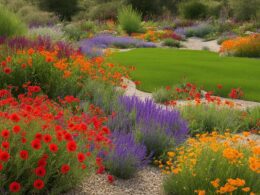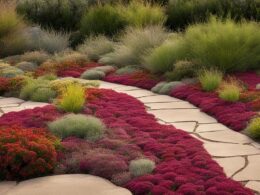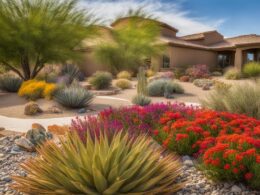Are you looking to create a sustainable and eco-friendly garden that conserves water and promotes environmental protection? Look no further than xeriscaping! This landscaping approach utilizes native plants that are well-adapted to the local climate, making them perfect for water conservation and sustainability.
Xeriscaping, a term coined by Denver Water in 1981, combines “xeros,” meaning dry, and “landscaping.” It has gained popularity worldwide as an affordable and environmentally friendly way to create beautiful, drought-resistant gardens.
Key Takeaways:
- Native plants in xeriscaping reduce water waste and withstand dry periods.
- Xeriscaping offers environmental benefits by conserving water and providing natural habitats for wildlife.
- Implementing xeriscaping involves choosing a native plant palette and using eco-friendly landscaping elements.
- The principles of xeriscaping include water conservation, soil improvement, limited turf area, and efficient irrigation methods.
- Xeriscaping offers benefits such as low maintenance, water savings, increased property value, and reduced pollution.
The Environmental and Aesthetic Benefits of Xeriscaping
Xeriscaping offers numerous environmental benefits. By reducing water usage, it helps conserve water, especially in arid regions. Native plants in xeriscaped gardens act as natural habitats for local wildlife, such as birds, insects, and lizards. Xeriscaping also reduces the need for pesticides and fertilizers, promoting a healthier and more sustainable ecosystem. In terms of aesthetics, xeriscaped gardens can be just as beautiful as traditional gardens. They can create a unique and visually appealing landscape that complements the natural surroundings, with a variety of colors, textures, and shapes provided by native plants.
In terms of environmental benefits, xeriscaping plays a crucial role in water conservation. By using native plants that are adapted to the local climate, xeriscaped gardens require less irrigation and can withstand dry periods. This reduces water waste and preserves precious resources, especially in regions prone to drought. In addition, the use of native plants in xeriscaping creates valuable habitats for local wildlife. Birds, insects, and other animals can find shelter, food, and nesting opportunities in these gardens, contributing to biodiversity and ecosystem health.
When it comes to aesthetics, xeriscaping offers a wide range of possibilities. With careful selection and placement of native plants, xeriscaped gardens can be visually stunning and highly attractive. The use of plants with different colors, textures, and sizes can create a dynamic and diverse landscape. Additionally, the unique characteristics of native plants can add a sense of authenticity and natural beauty to the garden. By embracing xeriscaping, homeowners can enjoy a beautiful and eco-friendly outdoor space that enhances the overall appeal of their property.
Table: Environmental and Aesthetic Benefits of Xeriscaping
| Environmental Benefits | Aesthetic Benefits |
|---|---|
| Conserves water | Creates visually appealing landscapes |
| Reduces the need for pesticides and fertilizers | Uses a variety of colors, textures, and shapes |
| Provides habitats for local wildlife | Complements the natural surroundings |
| Promotes a healthier and more sustainable ecosystem | Enhances the overall property appeal |
Overall, xeriscaping offers both environmental and aesthetic benefits. By embracing this landscaping approach, you can contribute to water conservation, support local wildlife, and create a visually stunning garden that enhances the beauty of your property. Whether you live in a dry region or simply want to adopt a more sustainable gardening practice, xeriscaping is a smart choice that brings beauty and environmental responsibility together.
How to Implement Xeriscaping in Your Garden
Implementing xeriscaping in your garden is a straightforward process that can be achieved with careful planning and consideration. By following a few key steps, you can create a beautiful and sustainable landscape that conserves water and promotes the health of local ecosystems.
1. Selecting a Native Plant Palette
Start by choosing a native plant palette that includes plants, trees, and grasses that naturally thrive in your region. Native plants are well-adapted to the local climate and require less maintenance and water compared to non-native species. They also provide important habitat and food sources for local wildlife. Consider consulting with local nurseries or botanical gardens to identify the best native plants for your area.
2. Incorporating Eco-Friendly Landscaping Elements
When implementing xeriscaping, it’s important to incorporate eco-friendly landscaping elements that support water conservation and sustainability. Use organic mulch to retain soil moisture, prevent weed growth, and improve overall soil health. Enhance the soil with compost to promote nutrient-rich conditions for plant growth. Consider installing a drip irrigation system that delivers water directly to plant roots, reducing evaporation and water waste.
3. Thoughtful Plant Placement
Take into consideration the water needs of different plants when deciding where to place them in your xeriscaped garden. Group plants with similar water requirements together to ensure efficient irrigation. Avoid overwatering by monitoring the soil moisture levels and adjusting watering schedules accordingly. Additionally, consider the natural sunlight and shade patterns in your garden to optimize plant growth and reduce water demand.
4. Taking a Proactive Drought Season Approach
Be proactive in preparing your xeriscaped garden for drought seasons. Implement rainwater harvesting techniques, such as collecting rainwater in barrels or cisterns, to supplement irrigation needs. Use water-efficient strategies, such as capturing and redirecting runoff water, to maximize water usage. Stay informed about local water restrictions and adjust your watering practices accordingly. By taking a proactive approach, you can ensure the long-term health and vitality of your xeriscaped garden.
By following these steps and utilizing local resources such as native plant nurseries or botanical gardens, you can successfully implement xeriscaping in your garden. Enjoy the beauty and benefits of a sustainable and water-efficient landscape that supports local ecosystems and conserves precious resources.
Xeriscaping Principles for Sustainable Landscaping
Xeriscaping is based on a set of principles that promote water conservation, soil improvement, and low-maintenance landscaping. By following these principles, you can create a beautiful and sustainable garden that not only saves water but also enhances the overall health of your outdoor space.
Water Conservation
One of the key principles of xeriscaping is water conservation. By selecting drought-tolerant native plants, you can significantly reduce the amount of water required for irrigation. These plants are naturally adapted to the local climate and require minimal supplemental watering once established. Implementing efficient irrigation methods such as drip systems or soaker hoses ensures that water is delivered directly to the roots, minimizing evaporation.
Soil Improvement
Improving the soil is essential for successful xeriscaping. Amending the soil with organic matter, such as compost, enhances its water retention capabilities and promotes healthy root growth. This improves the overall health and resilience of the plants, allowing them to better withstand periods of drought. Additionally, well-drained soil prevents waterlogging and reduces the risk of root rot.
Limited Turf Area
Limiting the amount of turf area in your landscape design is another important principle of xeriscaping. Traditional lawns require significant water resources to maintain their lush appearance, which is not environmentally sustainable. Instead, consider replacing large areas of grass with native plants, ground covers, or hardscape features. This not only reduces water demand but also decreases mowing and maintenance requirements.
Mulch
Applying mulch around your plants is a crucial aspect of xeriscaping. Mulch acts as a protective layer, conserving soil moisture by reducing evaporation. It also helps to suppress weeds, regulate soil temperature, and prevent erosion. Use organic mulch, such as wood chips or bark, to improve soil health and enhance the aesthetic appeal of your garden.
Irrigation and Maintenance
Efficient irrigation and proper maintenance are essential for the long-term success of a xeriscaped garden. Regularly check your irrigation system for leaks or inefficiencies, and adjust watering schedules based on the changing needs of your plants. Consider utilizing rainwater harvesting techniques to supplement your irrigation needs. In terms of maintenance, pruning and weeding are crucial to ensure the health and aesthetics of your xeriscape. Remove any dead or overgrown vegetation, and keep an eye out for pests or diseases that may affect your plants.
Incorporating these xeriscaping principles into your landscape design can help you create a sustainable and water-efficient garden that requires less maintenance. By conserving water, improving soil health, and utilizing native plants, you can enjoy a beautiful outdoor space while minimizing your environmental impact.
Table
| Principle | Description |
|---|---|
| Water Conservation | Select drought-tolerant native plants and implement efficient irrigation methods. |
| Soil Improvement | Amend the soil with organic matter to enhance water retention and root growth. |
| Limited Turf Area | Replace large areas of grass with native plants, ground covers, or hardscape features. |
| Mulch | Apply organic mulch to conserve soil moisture, suppress weeds, and prevent erosion. |
| Irrigation and Maintenance | Efficiently water plants, adjust irrigation schedules, and perform regular maintenance tasks. |
The Benefits of Xeriscaping
Xeriscaping offers a range of benefits that make it a popular choice for homeowners looking to create a beautiful and sustainable garden. One of the key advantages of xeriscaping is its low maintenance requirements. By using native plants that are well-adapted to the local climate, you can reduce the need for frequent watering, pruning, and weeding. This not only saves you time and effort but also helps conserve water resources, making xeriscaping an environmentally responsible choice.
Another significant benefit of xeriscaping is water savings. Traditional gardens often require a substantial amount of water to keep the plants healthy and thriving. In contrast, xeriscaping can reduce water usage by up to 75%. By using drought-resistant native plants and implementing efficient irrigation techniques such as drip systems, you can significantly reduce your water bills and contribute to water conservation efforts.
Aside from saving water and time, xeriscaping also provides environmental protection. By eliminating the need for pesticides and fertilizers, xeriscaped gardens promote a healthier ecosystem. Native plants attract local wildlife, creating a habitat for birds, insects, and other animals. Additionally, xeriscaping reduces pollution by minimizing the use of gas-powered mowers, which emit harmful emissions. The overall result is a garden that not only looks beautiful but also supports a sustainable and biodiverse environment.
Furthermore, xeriscaping can increase property value. A well-designed xeriscape with its unique and visually appealing landscape can enhance the curb appeal of your home. Potential buyers are often attracted to properties with low-maintenance gardens that are eco-friendly and water-efficient. Investing in xeriscaping can yield a higher return on investment and make your property stand out in the real estate market.
In addition to the aforementioned benefits, xeriscaping also offers cost savings. By reducing water consumption and minimizing the need for maintenance, xeriscaping can help lower your water bills and save money on landscaping services. Over time, these savings can add up, providing you with more resources to allocate to other priorities.
In summary, xeriscaping is a landscaping approach that provides numerous benefits. From low maintenance and water savings to environmental protection and increased property value, xeriscaping offers a holistic and sustainable solution for creating beautiful outdoor spaces. By embracing xeriscaping principles, you can enjoy a garden that not only enhances the aesthetic appeal of your property but also contributes to a greener and more sustainable future.
What are the benefits of using native plants in xeriscaping?
When it comes to ecofriendly xeriscaping, native plants have a lot to offer. These plants are well adapted to the local climate and soil conditions, requiring less water and maintenance. Using native plants in xeriscaping can help conserve water, reduce the need for pesticides, and promote biodiversity.
Conclusion
Xeriscaping is a sustainable and eco-friendly landscaping approach that offers numerous benefits. By utilizing native plants, conserving water, and reducing maintenance requirements, xeriscaped gardens enhance the beauty of your outdoor spaces while promoting environmental protection.
The combination of water savings, wildlife habitat creation, reduced pollution, and cost and time savings make xeriscaping an excellent choice for any garden. You can enjoy up to 75% water savings compared to traditional gardens, helping you conserve this precious resource for future generations.
Not only does xeriscaping benefit the environment, but it also adds value to your property and saves you money in the long run. With minimal maintenance and no need for pesticides or fertilizers, you’ll have more time to relax and enjoy your beautiful, drought-resistant garden.
Consider implementing xeriscaping principles in your garden to enjoy the many benefits it offers both for you and the planet. Start by choosing a native plant palette, improving soil health, and using efficient irrigation methods. Embrace xeriscaping and create a sustainable oasis that showcases the beauty and resilience of native plants.













